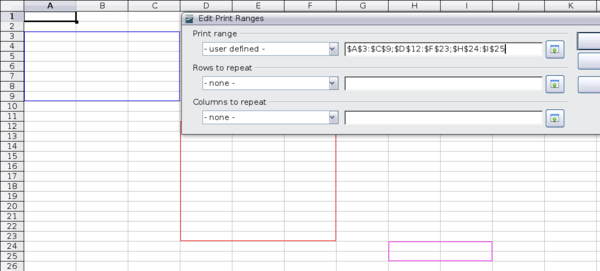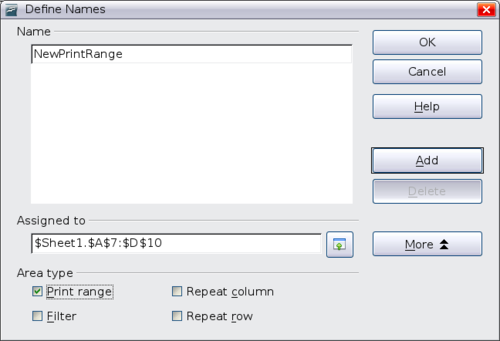Using print ranges
Print ranges have several uses, including printing only a specific part of the data or printing selected rows or columns on every page.
Defining a print range
To define a new print range or modify an existing print range:
- Highlight the range of cells that comprise the print range.
- Choose Format > Print Ranges > Define.
The page break lines display on the screen.
| You can check the print range by using File > Page Preview. OOo will only display the cells in the print range. |
Adding to the print range
After defining a print range, you can add more cells to it. This allows multiple, separate areas of the same sheet to be printed, while not printing the whole sheet. After you have defined a print range:
- Highlight the range of cells to be added to the print range.
- Choose Format > Print Ranges > Add. This adds the extra cells to the print range.
The page break lines no longer display on the screen.
| The additional print range will print as a separate page, even if both ranges are on the same sheet. |
Removing a print range
It may become necessary to remove a defined print range, for example if the whole sheet needs to be printed later.
Choose Format > Print Ranges > Remove. This removes all defined print ranges on the sheet. After the print range is removed, the default page break lines will appear on the screen.
Editing a print range
At any time, you can directly edit the print range, for example to remove or resize part of the print range. Choose Format > Print Ranges > Edit. If you have already selected a print range, the Edit Print Ranges dialog looks something like the figure below.
In this example, three rectangles are selected, each separated by a semicolon. The first is bounded by cell A3 ($A$3) in the top left and cell C9 ($C$9) in the bottom right corners. Clicking anywhere in the text entry box shows the currently selected print range on the screen, with each rectangle in a different color, as shown below.
After making any changes, click the Shrink icon ![]() next to the text entry box to redisplay the rectangles with their new values.
next to the text entry box to redisplay the rectangles with their new values.
To re-expand the Edit Print Ranges dialog, click the Shrink icon again.
Printing rows or columns on every page
If a sheet is printed on multiple pages, you can set up certain rows or columns to repeat on each printed page.
For example, if the top two rows of the sheet as well as column A need to be printed on all pages, do the following:
- Choose Format > Print Ranges > Edit. On the Edit Print Ranges dialog, type the rows in the text entry box under Rows to repeat. For example, to repeat rows 1 and 2, type $1:$2. This automatically changes Rows to repeat from - none - to - user defined -.
- To repeat columns, type the columns in the text entry box under Columns to repeat. For example, to repeat column A, type $A. This automatically changes Columns to repeat from - none - to - user defined -.
- Click OK.
| You do not need to select the entire range of rows to be repeated; simply select one cell in each row. |
Defining a custom print range
In addition to highlighting a print range for each print job, you can define a range of cells to be used repeatedly. This may be useful, for example, if there are different areas of a large spreadsheet that need to be printed for different reports. Several different print ranges can be defined to meet this need.
- To define a print range, use the same procedure as labeling an area of the sheet. Highlight the cells you want to define as a print range and select Insert > Names > Define. (The cells can be highlighted after opening the Define Names dialog as well.)
- On the Define Names dialog, type a name for the range in the text box with the blinking cursor. The name of the range cannot contain any spaces.
- Click the More button in the dialog and then select the Print range option. Click the Add button.
- To include more than one group of cells in the selection, type in the additional ranges. For example, to select the rectangle with A3 as the top left cell and F20 as the bottom right cell, enter ;$A$3:$F$20 or ;A3:F20 (both work and are equivalent) after the initial selection. Make sure that each group of cells is separated with a semicolon.
- Click OK.
To print this range:
- Choose Format > Print Ranges > Edit. The previously defined area now appears in the drop-down box under Print range.
- Select the defined print range and click OK.
This method can be useful to quickly change the print range without highlighting a large area of cells every time.
| If the cell range name refers to more than one group of cells, it will not appear in the drop-down list. You will need to type it in or highlight and select it |
| Content on this page is licensed under the Creative Common Attribution 3.0 license (CC-BY). |



